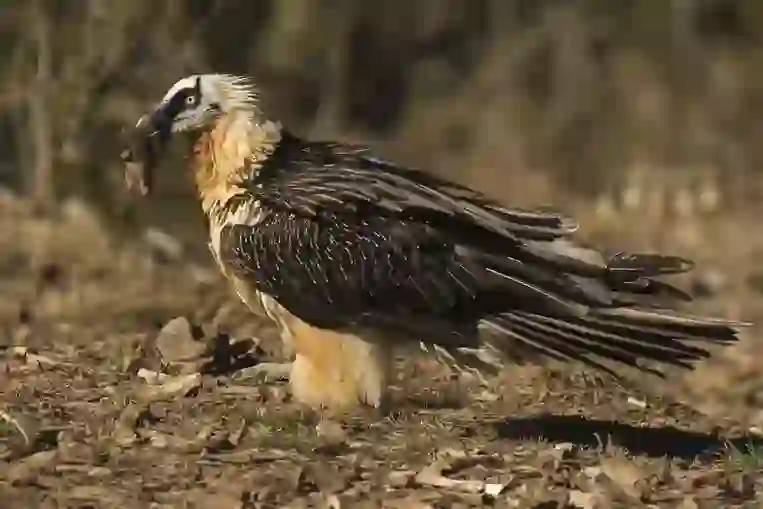
Bearded Vulture
Bearded Vulture
Bearded Vulture
In the mountainous regions of Europe, Asia, and Africa, there lives a fascinating eagle with a peculiar appetite for bones. This is the bearded vulture, known for its unique habit of dropping bones from great heights to break them open and consume the marrow within. Let's explore the secrets of the bearded vulture, delving into their ecology and the environment they inhabit.
Bearded Vulture Basic Infomation

| Property | Value |
|---|---|
| Scientific Name | Gypaetus barbatus |
| Taxonomic Status | SPECIES |
| Rank | SPECIES |
| Vernacular Names | Bearded Vulture, Lammergeier |
| Kingdom | Animalia |
| Phylum | Chordata |
| Class | Aves |
| Order | Accipitriformes |
| Family | Accipitridae |
| Genus | Gypaetus |
| Habitats | Mountainous regions of Europe, Asia, and Africa |
| Conservation Status | Near Threatened (NT) |

Size
They are about 3.3 to 4.6 feet (1 to 1.4 meters) long, with an impressive wingspan of 8.2 to 9.8 feet (2.5 to 3 meters)! They weigh about 11 to 15.4 pounds (5 to 7 kilograms). Females are larger than males.

Lifespan
Their lifespan in the wild is estimated to be about 20 years. In captivity, they can live for over 40 years.

Distribution
They are found in southern Europe, northern Africa, the Middle East, Central Asia, and the Himalayas. They inhabit mountainous regions, preferring cliffs and rocky outcrops at elevations between 3,280 to 13,120 feet (1,000 to 4,000 meters).
Bearded Vulture Q&A

What kind of eagle is the bearded vulture?
The bearded vulture is a large bird of prey belonging to the family Accipitridae and the genus Gypaetus.
They are named for the black, beard-like feathers below their beak. In English, they are called 'bearded vulture' or 'lammergeier.' The word 'lammergeier' comes from German and means 'lamb vulture.' This is because they were once mistakenly believed to prey on lambs. Unlike other eagles, they primarily feed on animal bones. They drop bones from great heights onto rocks to break them open and then eat the marrow inside. They also have extremely strong stomach acid that can dissolve bones.

Why do bearded vultures eat bones?
It is thought that bearded vultures evolved to eat bones as a way to avoid competition with other scavengers and efficiently obtain nutrients.
Bone marrow is highly nutritious and is a valuable food source for them. Bones are also rich in minerals, such as calcium, which are essential for their health. They have unique physical adaptations for eating bones. Their beaks are narrow and hooked, perfectly shaped for extracting marrow from bones. Their legs are short and powerful, ideal for gripping bones. Furthermore, they have extremely strong stomach acid that can dissolve bones. They are remarkably adapted to their bone-eating diet.

[Quiz!] From what height do bearded vultures drop bones?
Bearded vultures drop bones from heights of 164 to 328 feet (50 to 100 meters)!
They carefully select the drop zone, aiming for rocks to ensure the bones break. Once the bone is broken, they swoop down to eat the marrow. Sometimes they may even drop the bone repeatedly until it breaks. They are very persistent when it comes to accessing bone marrow.

[Quiz!] Why do bearded vultures have red feathers?
Adult bearded vultures have a white head and body with black wings. However, the feathers on their chest, belly, and legs are reddish-brown.
This is believed to be due to their habit of bathing in soil rich in iron oxide. The iron oxide stains their feathers reddish-brown. These red feathers are a symbol of beauty and a sign of health for them.

[Quiz!] Are bearded vultures endangered?
The bearded vulture is listed as 'Near Threatened' (NT) on the IUCN (International Union for Conservation of Nature) Red List.
This means that they are at high risk of becoming endangered in the near future. Their declining population is primarily attributed to these three factors:
・Habitat loss: Human development is encroaching on their mountainous habitat.
・Poaching: They are targeted by poachers for their feathers, talons, and beaks.
・Lead poisoning: They can be poisoned by ingesting lead bullets when scavenging on the carcasses of animals shot by hunters.
To protect bearded vultures, it is crucial to conserve their mountainous habitats, prevent poaching, and regulate the use of lead ammunition. We also need to raise awareness about the current situation of bearded vultures and encourage action to protect them.

Would you like to become a part of the 'Animalbook.jp'?
Turn your knowledge into Q&A and share it with the world. ※Publication will be activated after purchase. Let's share information together!
Bearded Vulture Type of List

Efforts to Protect Bearded Vultures
- Establishment of protected areas
- Strengthening law enforcement against poaching
- Regulation of lead ammunition
- Public awareness campaigns
- Captive breeding and reintroduction programs
Information
Congratulations! You are the first commenter!

Create Your Favorite List!
Bearded Vulture
Save the animals you love! Build your own list to quickly revisit your favorites later.

Would you like to leave a comment?
※Please note: This is for the purchase of rights to post comments within the article.
Find Your Favorites!
Our shop offers a unique and attractive selection of goods themed around various animals.
Bearded Vulture References
Bearded Vulture Introduction of media used

Francesco Veronesi from Italy, CC BY-SA 2.0, via Wikimedia Commons

Help Enrich Our Animalbook.jp with Your Media!
We are constantly looking to expand and enrich our Animalbook.jp with amazing photos and videos of animals. If you have any media that you'd like to share, please contribute and help us showcase the beauty and diversity of the animal kingdom. Your submissions will be credited and featured in our encyclopedia, reaching a wide audience of animal lovers.


















